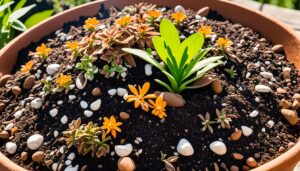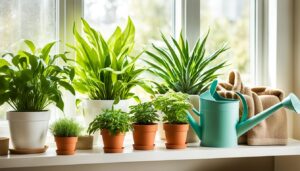Introduction:
Jade plants, known scientifically as Crassula ovata, are popular succulents prized for their resilience and attractive appearance. With their thick, fleshy leaves and woody stems, these plants are native to the arid regions of South Africa and are well-adapted to storing water for extended periods. While their low-maintenance nature makes them ideal houseplants for both novice and experienced gardeners alike, understanding the proper watering regimen is essential for their overall health and vitality.
The frequency of watering a jade plant is a crucial aspect of its care, as overwatering or underwatering can lead to issues such as root rot or dehydration. Unlike many other houseplants, jade plants have specific water requirements due to their succulent nature and the unique way they store moisture. Rather than adhering to a strict watering schedule, gardeners should learn to observe the signs that indicate when their jade plant is in need of hydration.
So, how often should you water your jade plant? This question does not have a one-size-fits-all answer, as several factors influence the frequency of watering, including the plant’s size, age, environment, and the season. In this guide, we’ll explore the principles of watering jade plants, discuss the signs of both overwatering and underwatering, and provide practical tips for maintaining optimal soil moisture levels to ensure your jade plant thrives for years to come.
Factors Influencing Jade Plant Watering Needs
Understanding the factors that influence the watering needs of jade plants is essential for maintaining their health and vigor. While there is no one-size-fits-all approach to watering these succulents, several key factors play a significant role in determining how often you should water your jade plant. By considering these factors and adjusting your watering routine accordingly, you can help ensure that your jade plant thrives in its environment.
Size of the Plant
: The size of your jade plant directly impacts its water requirements. Larger plants typically have more extensive root systems and therefore require more water than smaller plants. As a general rule, larger jade plants will need to be watered more frequently than their smaller counterparts to sustain their growth and hydration needs.Age of the Plant
: The age of the jade plant also influences its watering needs. Younger plants may require more frequent watering as they are actively growing and establishing their root systems. As the plant matures, its water requirements may decrease, but it is essential to monitor moisture levels consistently, especially during periods of growth or stress.Environmental Conditions
: Environmental factors such as temperature, humidity, and sunlight exposure can significantly affect the water requirements of jade plants. In warmer, drier climates, jade plants may need more frequent watering to prevent dehydration, while in cooler, more humid environments, watering needs may be reduced. Additionally, jade plants placed in areas with ample sunlight may require more water than those in lower light conditions due to increased evaporation rates.Seasonal Changes
: Seasonal fluctuations in temperature and light intensity can impact the watering needs of jade plants. During the warmer months of spring and summer, when growth is most active, jade plants may require more frequent watering to support their metabolic processes. In contrast, during the cooler months of fall and winter, when growth slows down, watering frequency may need to be reduced to prevent overwatering and root rot.Potting Mix and Container Type
: The type of potting mix and container used can also influence the watering requirements of jade plants. Well-draining soil mixes specifically formulated for succulents and cacti are ideal for jade plants, as they allow excess water to drain away quickly, preventing waterlogged roots. Additionally, pots with drainage holes facilitate proper drainage
Signs of Overwatering and Underwatering
Properly assessing the moisture needs of your jade plant is crucial for preventing both overwatering and underwatering, which can lead to serious health issues for the plant. Recognizing the signs of these conditions is key to adjusting your watering routine and ensuring the optimal growth and vitality of your jade plant. Below are common indicators of overwatering and underwatering to help you identify and address these issues promptly:
Signs of Overwatering:
- Yellowing or Drooping Leaves: Overwatered jade plants may develop yellow or translucent leaves that feel soft and mushy to the touch. In severe cases, the leaves may appear droopy or wilted due to waterlogged roots.
- Root Rot: Excessive moisture in the soil can lead to root rot, a fungal disease that causes the roots to become soft, dark, and foul-smelling. Infected roots are unable to absorb water and nutrients properly, resulting in stunted growth and overall decline.
- Mold or Fungus Growth: Wet, humid conditions promote the growth of mold, mildew, and fungus on the soil surface or around the base of the plant. These pathogens can further exacerbate root rot and compromise the plant’s health.
- Slow Growth or Yellowing Lower Leaves: Overwatered jade plants may exhibit slow growth or yellowing of lower leaves as a result of nutrient deficiencies caused by impaired root function. The plant may also appear leggy or stretched due to weakened stems.
Signs of Underwatering:
- Shriveled or Wrinkled Leaves: When deprived of adequate moisture, jade plants will conserve water by shrinking their leaves, causing them to appear shriveled or wrinkled. The leaves may also feel dry and crispy to the touch.
- Leaf Drop: Underwatered jade plants may shed their lower leaves as a survival mechanism to reduce water loss through transpiration. Leaf drop typically starts with the older, lower leaves first.
- Stunted Growth: Insufficient water uptake can hinder the plant’s metabolic processes and growth, resulting in stunted or slow growth over time. New growth may be sparse, and existing leaves may appear smaller than usual.
- Brittle or Yellowing Leaves: Underwatered jade plants may develop brittle or yellowing leaves due to nutrient deficiencies and cellular damage caused by water stress. The leaves may also exhibit browning or crisping at the tips and edges.
Practical Tips for Watering Jade Plants
Maintaining the right balance of moisture is crucial for the health and vitality of jade plants. While there’s no one-size-fits-all approach to watering these succulents, incorporating certain practical tips into your watering routine can help ensure optimal growth and prevent common issues such as overwatering and underwatering. Here are some valuable tips to keep in mind when watering your jade plant:
Use a Well-Draining Potting Mix:
- Choose a potting mix specifically formulated for succulents and cacti, or create your own blend using equal parts of potting soil, perlite, and coarse sand.
- Ensure the potting mix has excellent drainage properties to prevent water from pooling around the roots, which can lead to root rot.
Select the Right Container:
- Opt for a pot with drainage holes at the bottom to allow excess water to escape freely. This helps prevent waterlogging and promotes healthy root development.
- Consider using a terra cotta or porous ceramic pot, which allows for better airflow and moisture regulation compared to plastic containers.
Water Sparingly but Thoroughly:
- Allow the top inch or two of the soil to dry out completely between watering sessions. Stick your finger into the soil to gauge moisture levels before watering.
- When watering, apply water evenly across the soil surface until it begins to drain out of the bottom of the pot. Ensure thorough saturation without leaving the plant sitting in standing water.
Adjust Watering Frequency Based on Environmental Factors:
- Increase watering frequency during the warmer months of spring and summer when jade plants are actively growing and transpiring more moisture.
- Reduce watering frequency during the cooler months of fall and winter when growth slows down and evaporation rates decrease.
Water from the Bottom:
- To prevent water from splashing onto the leaves and causing potential fungal issues, consider watering your jade plant from the bottom.
- Place the pot in a shallow tray filled with water and allow the soil to soak up moisture from the bottom. Discard any excess water after a few hours.
Monitor Plant Behavior:
- Pay close attention to your jade plant’s appearance and behavior to determine its watering needs. Look for signs of overwatering or underwatering, such as leaf discoloration, wilting, or softness.
- Adjust your watering frequency and volume accordingly based on your plant’s response and environmental conditions.
Watering Frequency Guidelines for Jade Plants
Determining the appropriate watering frequency for your jade plant is crucial for maintaining its health and preventing issues such as root rot or dehydration. While individual watering needs may vary based on factors like environment and plant size, having general guidelines can help you establish a consistent watering routine. Below are some watering frequency guidelines to consider when caring for your jade plant:
Observation and Monitoring:
- Regularly observe your jade plant and monitor its soil moisture levels to determine when watering is necessary. Use a moisture meter or simply stick your finger into the soil to assess its dryness.
Seasonal Considerations:
- Adjust your watering frequency based on the season. During the active growing season in spring and summer, jade plants typically require more frequent watering to support their growth and metabolic processes. In contrast, reduce watering frequency during the dormant period in fall and winter when growth slows down.
Size of the Plant:
- Larger jade plants with more extensive root systems may require watering more frequently than smaller plants. However, be cautious not to overwater, as larger pots retain moisture for longer periods.
Environmental Conditions:
- Consider the environmental factors that influence water evaporation and absorption rates, such as temperature, humidity, and sunlight exposure. Warmer, drier conditions may necessitate more frequent watering, while cooler, more humid conditions may require less.
Soil Type and Drainage:
- Ensure your jade plant is potted in well-draining soil to prevent waterlogging. Use a soil mix specifically formulated for succulents or amend regular potting soil with perlite or coarse sand to improve drainage.
Watering Techniques:
- Water your jade plant thoroughly but infrequently. Allow the soil to dry out completely between watering sessions to prevent water accumulation and root rot.
- Consider bottom watering by placing the pot in a shallow tray of water and allowing the soil to soak up moisture from the bottom. This method helps avoid wetting the leaves and promotes even moisture distribution.
Adjusting Based on Plant Response:
- Pay attention to how your jade plant responds to your watering routine. If you notice signs of overwatering, such as yellowing leaves or soggy soil, reduce watering frequency. Conversely, if the plant appears wilted or shows signs of dehydration, increase watering frequency.
Watering Frequency Guidelines for Jade Plants:
Plant Size | Spring/Summer Frequency | Fall/Winter Frequency |
Small (6 inches) | Every 2-3 weeks | Every 3-4 weeks |
Medium (12 inches) | Every 3-4 weeks | Every 4-6 weeks |
Large (18 inches) | Every 4-6 weeks | Every 6-8 weeks |
Conclusion
Mastering the art of watering jade plants is fundamental to their overall health and longevity. These resilient succulents, with their captivating appearance and low-maintenance nature, thrive when provided with the right balance of moisture. Throughout this guide, we’ve explored the essential factors to consider when watering jade plants and provided practical tips for establishing a successful watering routine.
By understanding the unique needs of jade plants and observing their behavior closely, gardeners can avoid common pitfalls such as overwatering and underwatering. Recognizing the signs of these conditions, such as leaf discoloration, wilting, or root rot, empowers individuals to adjust their watering practices accordingly and promote optimal plant health.
Moreover, implementing proper watering techniques, such as using well-draining soil mixes, selecting suitable containers with drainage holes, and adjusting watering frequency based on seasonal and environmental factors, can significantly contribute to the success of jade plant cultivation. Additionally, employing bottom watering methods and monitoring soil moisture levels allow for precise control over watering and help prevent moisture-related issues.
In essence, caring for jade plants is a rewarding endeavor that requires patience, observation, and a commitment to understanding their unique needs. By following the guidelines outlined in this article and adapting them to individual circumstances, gardeners can ensure that their jade plants thrive and continue to grace their spaces with their beauty for years to come.




